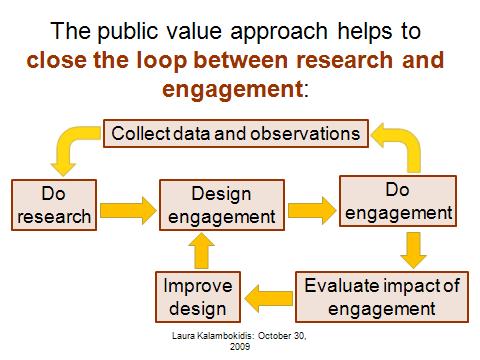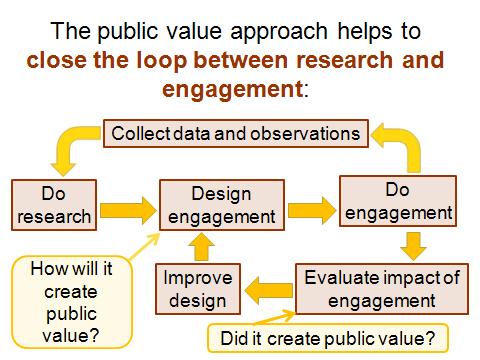When I ask Extension professionals to name Extension’s strengths relative to other providers of outreach education, the connection between Extension programs and university research inevitably is the the first item on the list. We build on that key strength when we deliver programs that are based on the best research, and the community’s needs inform the research agenda: that is, when we close the loop between research and Extension. I focused on this relationship–substituting “engagement” for “Extension”–at the Purdue Scholarship of Engagement Workshop last week.
Here’s how I think an Extension team can close that loop: They (or someone else) conduct research that leads to a discovery (knowledge creation) that could help address a condition of concern in a community (middle left box in the diagram). The team designs their Extension or engagement program with a curriculum that is based on the new knowledge, as well as existing best practices regarding program design and delivery (middle box). If the team is truly “engage” with their community partner, then the partner’s needs and strengths will also inform the design of the program. The team conducts their program (middle right box) while also collecting data and observations that can be used to inform the research agenda (top box). This way, what is observed and learned “in the field” makes its way back to the lab to influence the direction of future research. The team also implements their program evaluation plan, which helps them evaluate the impact of the Extension or engagement program (lower right box). The results of the evaluation helps them improve the program design (lower middle box), so greater impact will result next time.
Where does public value come into this scheme? I can think of at least two places: First, in the design phase, the team will plan how they expect the program to create public value. What are the expected impacts and outcomes, and how do they create benefits for sstakeholders who are not the program’s direct beneficiaries? Second, in the evaluation phase, team members will assess whether those expected outcomes were generated: whether public value was created.
I can think of a few ways a team can increase their success at closing the loop:
*Form a team that includes researchers, Extension educators, and program evaluators.
*Embed the program evaluation plan into program design.
*Develop and implement a plan for collecting observations and data arising from the Extension or engagement program.
*Keep up to date on relevant research developments.
*Plan for steps to take once the program ends (e.g., analyzing data and revisiting the program design).
Do you think closing the loop between research and engagement is crucial? Can you suggest ways to make it happen more systematically in Extension?


